Note: There is now a newer Novel Coronavirus (COVID-19) Situation Report 60.
WHO Novel Coronavirus (COVID-19) Situation Report 59
- Seven new countries/territories/areas (African Region (3), Eastern Mediterranean Region (1), European Region (1), and Region of the Americas (2)) have reported cases of COVID-19.
- The number of confirmed cases worldwide has exceeded 200,000. It took over three months to reach the first 100 00 confirmed cases, and only 12 days to reach the next 100,000.
- A new protocol to investigate the extent of COVID-19 infection in the population, as determined by positive antibody tests in the general population has been developed. The protocol is titled the Population-based age-stratified seroepidemiological investigation protocol for COVID-19 virus infection. See Subject in Focus below for details.
Risk Assessment
Global Level: Very High
Coronavirus Situation in Numbers
Globally
- 209,839 confirmed cases (16,556 new)
- 8,778 deaths (828 new)
Western Pacific Region
- 92,333 confirmed cases (488 new)
- 3,377 deaths (20 new)
European Region
- 87,108 confirmed cases (10,221 new)
- 4,084 deaths (591 new)
South-East Asia
- 657 confirmed cases (119 new)
- 23 deaths (14 new)
Eastern Mediterranean Region
- 19,518 confirmed cases (1,430 new)
- 1,161 deaths (150 new)
Regions of the Americas
- 9,144 confirmed cases (4,166 new)
- 119 deaths (50 new)
African Region
- 367 confirmed cases (132 new)
- 7 deaths (3 new)
Subject in Focus: New protocol for Early Epidemiologic investigations for public health response
With the emergence of COVID-19 virus, many uncertainties remain as to certain epidemiological, seroepidemiological (related to identifying antibodies in the population), clinical and virological characteristics of the virus and associated disease. Studies to assess these characteristics in different settings are critical to furthering our understanding. They will also provide the robust information needed to refine forecasting models and inform public health measures.
As such, WHO, in collaboration with technical partners, has adapted early epidemiological investigation protocols from pandemic influenza and from MERS-CoV, to better understand these characteristics and how they may be used to inform public health measures.
To date, five early seroepidemiological core protocols and data collection forms are available on the WHO COVID-19 Technical guidance website.
All protocols propose a standardized methodology to allow data and biological samples to be systematically collected, taking into consideration local setting and outbreak characteristics, and shared rapidly in a format that can be easily aggregated, tabulated, and analyzed across many different settings globally.
| Study Protocol | Objectives |
|---|---|
| The First Few COVID-19 cases and contacts transmission investigation protocol (FFX) | To provide descriptions and/or estimates of the:
|
| Households transmission of COVID-19 investigation protocol |
|
| Assessment of COVID-19 risk factors among Health workers protocol |
|
| Surface sampling of COVID-19 for health care professionals |
|
| Population based serologic survey |
|
The latest protocol, the Population-based age-stratified seroepidemiological investigation protocol for COVID-19 virus infection, is intended to provide key epidemiological and serologic characteristics of COVID-19 virus in the general population. Specifically, data from this protocol will provide critical information about the extent of infection (as measured by the presence of antibodies in study subjects) in the general population, age-specific infection cumulative incidence, and the fraction of people with asymptomatic or subclinical infection.
The results of these investigations, whether individually or pooled across study sites/countries, will allow further understanding and provide robust estimates of key clinical, epidemiological, and virological characteristics of the COVID-19 virus, including:
- Key epidemiological parameters, such as: secondary infection rate and secondary clinical attack rate of COVID-19 infection among close contacts, asymptomatic fraction of infection, serial interval and incubation period of COVID-19, the basic reproduction number of COVID-19 infection
- Clinical presentation of COVID-19 infection and course of associated disease
- Risk factors for transmission and infection, and identification of possible routes of transmission
- Impact of infection prevention and control measures in health care settings
- Serological response following symptomatic COVID-19 infection
- Age-stratified seroprevalence of antibodies against COVID-19 virus
- Cumulative incidence of infection, including extent of age-specific infection
- Infection and disease-severity ratios (case-hospitalization ratio [CHR] and case-fatality ratio [CFR])
- Viral load and shedding profiles
- Viral persistence on surfaces
To date, 13 countries across five of the six WHO regions, including both high-income and low-and middle-income countries, have begun to implement at least one of the early investigation protocols. A further 18 countries have signaled their intention to implement one of the protocols. WHO will continue to support countries in their epidemiological investigations through the provision of clear and comprehensive protocols.
For more information, please contact: [email protected]
Countries, territories or areas with reported laboratory-confirmed COVID-19 cases and deaths, March 19, 2020
| Country/Territory/Area | Confirmed Cases |
|---|---|
| China | 81174 |
| Italy | 35713 |
| Iran | 17361 |
| Spain | 13716 |
| France | 9043 |
| Republic of Korea | 8413 |
| Germany | 8198 |
| United States of America | 7087 |
| Switzerland | 3010 |
| United Kingdom | 2630 |
| Netherlands | 2051 |
| Austria | 1646 |
| Belgium | 1486 |
| Norway | 1423 |
| Sweden | 1279 |
| Denmark | 1044 |
| Japan | 873 |
| International (Diamond Princess Cruise Ship) | 712 |
| Malaysia | 673 |
| Portugal | 642 |
| Canada | 569 |
| Czech Republic | 522 |
| Australia | 510 |
| Qatar | 442 |
| Israel | 427 |
| Greece | 418 |
| Finland | 359 |
| Singapore | 313 |
| Ireland | 292 |
| Brazil | 291 |
| Poland | 287 |
| Slovenia | 286 |
| Estonia | 258 |
| Bahrain | 256 |
| Iceland | 250 |
| Romania | 246 |
| Pakistan | 241 |
| Chile | 238 |
| Saudi Arabia | 238 |
| Indonesia | 227 |
| Thailand | 212 |
| Luxembourg | 210 |
| Egypt | 196 |
| Turkey | 191 |
| Philippines | 187 |
| Iraq | 164 |
| Ecuador | 155 |
| Russian Federation | 147 |
| Peru | 145 |
| Kuwait | 142 |
| India | 137 |
| Lebanon | 133 |
| South Africa | 116 |
| United Arab Emirates | 113 |
| San Marino | 109 |
| Slovakia | 105 |
| Serbia | 96 |
| Colombia | 93 |
| Mexico | 93 |
| Bulgaria | 92 |
| Panama | 86 |
| Armenia | 84 |
| Croatia | 81 |
| Argentina | 79 |
| Algeria | 72 |
| Latvia | 71 |
| Vietnam | 66 |
| Albania | 59 |
| Cyprus | 58 |
| Faroe Islands | 58 |
| Hungary | 58 |
| Brunei Darussalam | 56 |
| Jordan | 52 |
| Costa Rica | 50 |
| Morocco | 49 |
| Malta | 48 |
| Belarus | 46 |
| Palestinian Territory | 44 |
| Sri Lanka | 42 |
| Andorra | 39 |
| Georgia | 38 |
| Bosnia and Herzegovina | 36 |
| Kazakhstan | 36 |
| North Macedonia | 36 |
| Republic of Moldova | 36 |
| Senegal | 36 |
| Venezuela | 36 |
| Cambodia | 35 |
| Azerbaijan | 34 |
| Guadeloupe | 33 |
| Oman | 33 |
| Tunisia | 29 |
| Uruguay | 29 |
| Burkina Faso | 26 |
| Lithuania | 26 |
| Liechtenstein | 25 |
| Martinique | 23 |
| Afghanistan | 22 |
| Dominican Republic | 21 |
| New Zealand | 20 |
| Ukraine | 16 |
| Uzbekistan | 16 |
| Jamaica | 13 |
| Maldives | 13 |
| Bolivia | 12 |
| French Guiana | 11 |
| Paraguay | 11 |
| Réunion | 11 |
| Rwanda | 11 |
| Bangladesh | 10 |
| Cameroon | 10 |
| Cuba | 10 |
| Côte d’Ivoire | 9 |
| Ghana | 9 |
| Honduras | 9 |
| Monaco | 9 |
| Gibraltar | 8 |
| Nigeria | 8 |
| Democratic Republic of the Congo | 7 |
| Kenya | 7 |
| Trinidad and Tobago | 7 |
| Ethiopia | 6 |
| Guatemala | 6 |
| Seychelles | 6 |
| Jersey | 5 |
| Guam | 5 |
| Mongolia | 5 |
| Puerto Rico | 5 |
| Aruba | 4 |
| Guyana | 4 |
| Saint Martin | 4 |
| Bahamas | 3 |
| Congo | 3 |
| Curaçao | 3 |
| Equatorial Guinea | 3 |
| French Polynesia | 3 |
| Gabon | 3 |
| Mauritius | 3 |
| Mayotte | 3 |
| Kyrgyzstan | 3 |
| Saint Barthelemy | 3 |
| United Republic of Tanzania | 3 |
| Barbados | 2 |
| Greenland | 2 |
| Liberia | 2 |
| Mauritania | 2 |
| Montenegro | 2 |
| Namibia | 2 |
| Saint Lucia | 2 |
| Sudan | 2 |
| Virgin Islands | 2 |
| Zambia | 2 |
| Antigua and Barbuda | 1 |
| Benin | 1 |
| Bhutan | 1 |
| Cayman Islands | 1 |
| Central African Republic | 1 |
| Djibouti | 1 |
| Eswatini | 1 |
| Gambia | 1 |
| Guernsey | 1 |
| Guinea | 1 |
| Holy See | 1 |
| Montserrat | 1 |
| Nepal | 1 |
| Saint Vincent and the Grenadines | 1 |
| Somalia | 1 |
| Suriname | 1 |
| Togo | 1 |
| Total | 209839 |
Recommendations and Advice for the Public
If you are not in an area where COVID-19 is spreading, or if you have not traveled from one of those areas or have not been in close contact with someone who has and is feeling unwell, your chances of getting it are currently low. However, it’s understandable that you may feel stressed and anxious about the situation. It’s a good idea to get the facts to help you accurately determine your risks so that you can take reasonable precautions.
Your healthcare provider, your national public health authority and your employer are all potential sources of accurate information on COVID-19 and whether it is in your area. It is important to be informed of the situation where you live and take appropriate measures to protect yourself.
If you are in an area where there is an outbreak of COVID-19 you need to take the risk of infection seriously. Follow the advice issued by national and local health authorities. Although for most people COVID-19 causes only mild illness, it can make some people very ill. More rarely, the disease can be fatal. Older people, and those with pre-existing medical conditions (such as high blood pressure, heart problems or diabetes) appear to be more vulnerable.

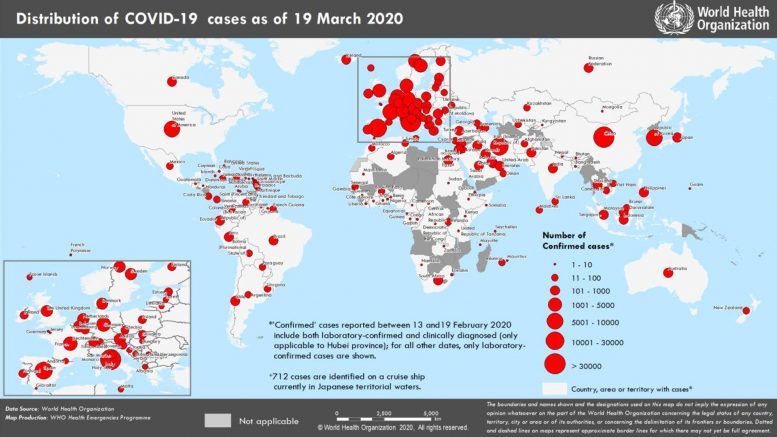
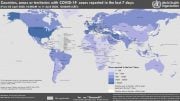
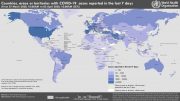
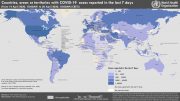
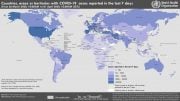
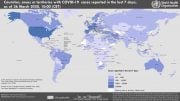
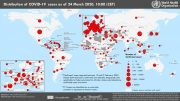
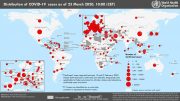
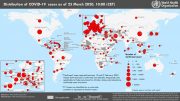
Be the first to comment on "COVID-19 World Map: 209,839 Confirmed Cases; 167 Countries; 8,778 Deaths"